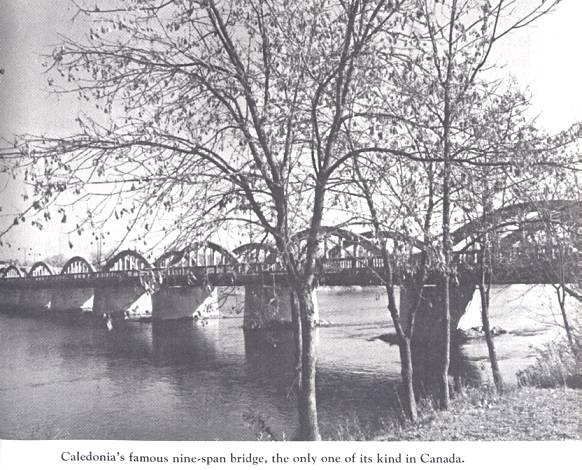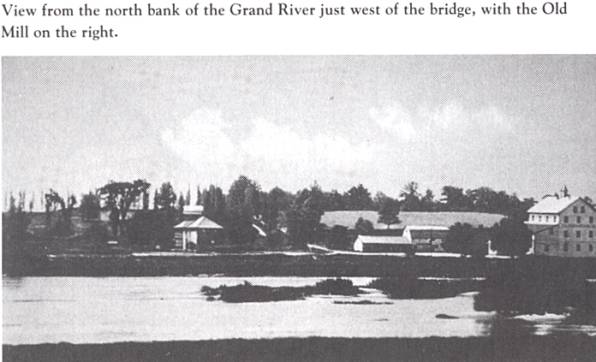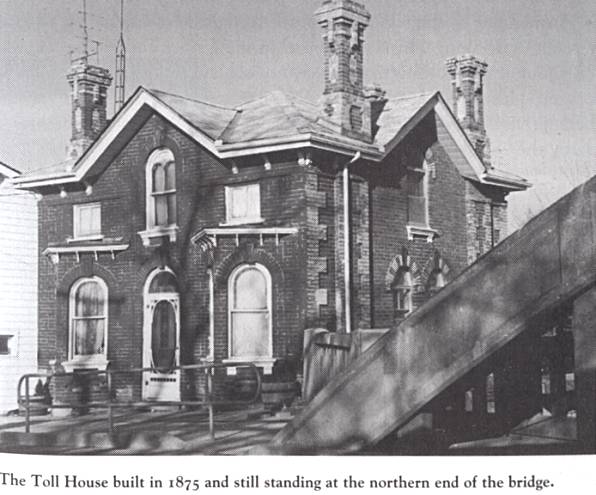The Town Hall soon became the centre of the community.
The basement housed the jail and a meat market. Stalls were set
up for butchers to carry on business inside the
"Caledonia Market House", advertised to be open everyday except Sunday.
Until 1955 the main floor held the apartment quarters for the town’s
constable. The Constable’s wife was expected to serve meals to the
prisoners, who were usually locked up for drunkenness.

The town’s character of the 1930’s was a frequent guest
in the jail. The story is told of this fellow who as a young lad knew the
Bible well and wanted to be a preacher. He didn’t fulfill his ambition,
but instead cleaned septic tanks for a living and became a habitual
drinker. One day during a spring flood, he was seen sitting in front of
his house on the river bank just west of the bridge with a bottle of
spirits in hand while the Grand River rose around him, singing in a loud
voice "Rescue the Perishing". He was rushed off to jail where,
it was said, he always enjoyed his stay.
The top floor of the Town Hall was used by Council for
meetings and as a hall for social events. Happenings as diverse as
Chautauqua Shows, concerts, wrestling matches, court hearings, short
courses and W.I. meetings were once held here. Boy Scouts and Girl Guides
had weekly nights for group meetings. A library was housed on the upper
floor as well. In 1917, the year women first got their vote, a polling
station was located there. Some senior Caledonians still remember that
landmark day for Canada.
After 1955 Council meetings were held on the main
floor. Other than a place for the Public Utilities administration, Red
Cross storage and a lawn bowling clubhouse, the Town Hall became
relatively inactive. It stood almost vacant after Regional Government took
over municipal affairs in 1974. At that time all administrative activities
and Council Meetings were moved to an administration building in Cayuga.
Never had there been such an eruption of public outcry
as in 1974 when it was suggested the Town Hall should be
torn down to make room for parking facilities. Although the Public
Utilities office had remained in the building, essentially it was unused
and needed many repairs. However, as a consequence of the public uproar
over the suggestion of demolition, the Town Hall was saved. On January 25,
1982 it was designated as a Heritage building, on its way to becoming a
museum, ensuring its place of pride and usefulness in the community.
The Town Hall’s exterior was given a complete facelift,
including wheelchair accessibility. During a colourful ceremony in
September of 1983 a replica of the original cupola was lifted to its
rooftop. A fundraising committee was established the following year to
begin the long arduous trek toward renovating the inside in preparation
for its becoming a museum. It would not be until the spring of 1988 that
the old Town Hall was finally reopened, this time as the Edinburgh Square
Heritage and Cultural Centre.
Today the main floor holds a display room for the
historical artifacts of years gone by, along with office and washroom
facilities. The modem staircase has been relocated to make the basement
and the third floor area easily accessible. The meat market found years
ago on the basement level is now a work area for preparing artifacts for
display. As well, a gift shop has been included in this area. The "public
lock-up" jail cell remains as a remembrance of the Town Hall’s beginning.
Even the monstrous safe has been kept for storage of valuables.
The third floor is once again a meeting room for
community events. A small kitchenette and the Gillespie Clark Library
Resource Centre is filled with books and documents containing town
history. Here the Grand River Sachem newspaper files from 1856 to
the present day can be researched in the library. A piano has been donated
by The Music Teachers Association and placed in the meeting room for small
concerts and recitals. Currently the Edinburgh Square Heritage and
Cultural Centre is administered by The Town of Haldimand, a Board of
Directors, a Curator, Barbara Lang Walker and an enthusiastic group of
volunteers. It is a proud symbol of the achievement of a heritage-minded
community.
The Landmark — The
Caledonia Bridge
More than sixty years old, this symbol of Caledonia was
said in 1927 to be the first reinforced concrete arch bridge ever built.
Today it is recognized as the only nine-span bridge of its kind in Canada.

Built by the Department of Public Highways of Ontario,
its contractor was the Randolph Macdonald Company Limited of Toronto and
the designing engineer was A.B. Crealock from the Ontario Department of
Public Highways. Work was completed in just one hundred and forty working
days from June 7th to November 19th, 1927, a major feat of the time.
The bridge is 700 feet long with eight concrete piers
and two concrete abutments. Each of the nine spans is 72 feet 7 inches
(21.12 metres) long. The width is about 42 feet (12.5 metres) with
sidewalk and hand-railing on each side. Its strength is attributed to the
bow-string-type trusses. The bow strings are of reinforced concrete with
square columns which support the spans. The foundations for the piers were
excavated to solid ground rock and the concrete poured on this foundation.
A gala two-day affair was held to open the newly
completed bridge. The celebration included a dance sponsored by the
Caledonia Fire Brigade on that very mild Friday November evening. On
Saturday, people from the district gathered on the bridge in the afternoon
to hear provincial government officials pay tribute. The bridge was
declared officially open at 3:00 p.m. when a pair of gold scissors used by
T.J. Mahony, M.L.A. for South Wentworth, severed the wide white satin
ribbon at the north end. A procession led by the Caledonia Citizen Band
was the first to cross the new bridge and the first car to cross carried
the wife of the contractor.
The crowd then adjourned to the Opera House to hear a
program of laudatory speeches including one by B.E. French, Reeve of
Caledonia, who declared the new bridge second to none in the province.
Members of County Council, Town Council and other dignitaries moved on to
the Union Hotel to conclude the festivities.
Just after the crowd had dispersed from the bridge
location, a runaway horse couldn’t resist the attraction. The Sachem
reported that R.J. Thompson was driving down Argyle Street in a
democrat, sitting on a cream can and holding a gasoline engine, when the
breeching strap on the harness broke. His horse panicked and couldn’t be
stopped until it reached the other side of the bridge. No one was hurt,
but spectators said the first runaway over the new bridge was a real John
Gilpin ride.
During the summer of 1984 extensive repairs were made
to the bridge to further strengthen the structure for today’s heavy
traffic. Motorists continue to use the bridge despite the construction a
year before of a bypass around Caledonia to lessen traffic passing through
the town.
Former Bridges
There had been two permanent bridges built before the
present bridge. The first was a sixty feet wide wooden structure,
reinforced with steel plates. It had six spans, one of which was a swing
section. Built in 1842, it lasted for only nineteen years until jams of
ice floes and floating logs destroyed it during the spring thaw of 1861.
Temporary bridges were built between 1861 and 1875.
Although the Halidmand Navigation Company still held navigation rights on
the river there was little river traffic to warrant building a swing
section on a new bridge. For a sum of $400 they agreed to dispense with
this requirement. Consequently a new solid iron structure was built at a
cost of $22,500 with a Toll House going up to pay the debt.
This 1875 bridge had six spans of 105 feet (32 metres)
each supported by a cast iron bow-string truss manufactured at the Scott
Foundry of Caledonia. It was built with a wood floor, a wooden wall on
either side for protection and a six foot wooden sidewalk along the west
side. A swing iron gate at the north end prevented drivers from passing
through without paying the toll.
This bridge withstood the raging Grand River, in
particular the spring floods, for fifty years. There are people who still
remember the disaster that occurred at 3 p.m. on Monday, August 24, 1925.
A large truck loaded with stone, driving from the south end reached the
middle span only to have the span collapse behind it. The driver felt the
rear of the truck tilt downward and instantaneously the air was filled
with flying timber and iron. Truck, driver and span dropped into the river
some 30 feet (9 metres) below. Somehow the vehicle remained upright when
it struck the river bed. Miraculously, the driver was unhurt. He
immediately jumped out of the truck to rescue a boy who had disappeared
with the fallen sidewalk. Twenty children bathing in the shallow water
under the fourth pier were uninjured.
When the span collapsed, it was described as "the bang
that woke the town". Women at their clotheslines on that Monday afternoon
wondered what had happened. Others busy with their summer canning were
upset at having the gas go off. The gas main had been broken as a result
of the collapse and there was some fear of an explosion. However, their
concerns were unfounded and repairs took place very quickly. The span also
was reconstructed and the bridge was reopened to traffic on September
3oth, 1925.
Negotiations immediately took place between the
Provincial Government and County Council for the construction of a new
bridge. The old one was demolished by the contractor to make room for the
new bridge. During construction, in the summer of 1927, a temporary bridge
was erected to the west of the construction site to accommodate the
welcoming home of the Old Boys and Girls of Caledonia.
The Bridge Without A Reason
There is a small steel bridge in the Caledonia vicinity
that will not wear out from use. This bridge is known today as Seneca
Bridge, but was known previously as Black Creek Bridge. Located on the
eastern outskirts of Caledonia in Seneca Park, it appears to be a bridge
built without a reason, but the historic plaque placed there in 1989
stamps it as a heritage site.
Contractor Melvin Runchey constructed the steel rod
structure for $1,400 in 1913. The Hamilton Bridge Works was paid $1,000
for steel structure material, J.H. Creighton was paid almost $100 for
providing planking and the Caledonia Milling Company $114.50 for cement
and lumber. Contractor Runchey offered his services for $100 per month and
was paid $200.

Originally the old river road needed a bridge to cross
Black Creek until 1950. The building of the new No. 54 highway led to the
route of the creek being diverted to flow into the river west of the
bridge. The bridge lost its purpose. If there is a reason for Seneca
Bridge today, it is as a reminder of those days when travelling and the
pace of life were not as hectic.
The Old Mill
The Old Mill is the only mill left. Today it stands to
remind us of the early milling days in Caledonia. Its historic importance
was recognized by the Local Architectural Conservation Advisory Committee
(LACAC) in 1989 when it was declared a Heritage building. The Mill was
built by James Little in the 1850’s to process
wheat into flour. Considered to be the best example of an operational mill
left on the river, it is a monument to the community’s beginning.

The Golden Horseshoe Antique Society was assigned by
the Town of Haldimand to manage the restoration of the Old Mill. The
Society has solicited co-operation from the York-Grand River Historical
Society for this project. Although the inside remains untouched, the
outside has been refurbished with paint and attractive lighting and the
building has been wired for security.
Plans for restoration are extensive. The committee
hopes to divert water from the Grand River into the millrace to
re-activate the original power turbines which are still intact and
operable. Some of the milling machinery had been removed by the Grand
River Conservation Authority in 1980 to refurbish Apps Mill near Paris.
However, the restoration committee, spearheaded by enthusiasts Fred
Thompson and AIf Peart, has acquired most of the missing machinery from
various sources.
Authentic Caledonia Milling Co. "Peerless" flour bags
and "Peerless" flour barrel top labels were left in the Old Mill from the
days of operation. The Restoration Committee presents laminated originals
to those whose generous donations enable the restoration work to move
forward. The Old Mill, situated just east of the Caledonia bridge,
provides background scenery for photographers wanting to capture the
heritage essence of Caledonia’s beginning.
Built To Take Tolls
The Toll House stands today as a reminder that once
upon a time a toll was paid every time one crossed the Caledonia bridge.
This substantial brick building, located in the downtown area at the north
end of the bridge, was built in 1875 at the same time as the bridge.
Constructed specifically as a residence for the Toll Keeper, it was used
for this purpose until the late 1800’s. The County owned both the Bridge
and Toll House and sold the right to collect tolls. The person who had the
highest tender lived in the Toll House and, of course, made sure no-one
passed over without paying.

In 1856 a warning was published that, "the travelling
public may as well observe that nothing is to be gained by taking to the
ice and avoiding the toll for the Bridge, spanning the River at this
place. On Monday last a span of horses crossing the ice, broke through and
were rescued with much difficulty. On arriving at the east side of the
stream, the gatekeeper demanded the toll and we believe got it. Teamsters
will please make a note and govern themselves accordingly.
Before tolls were abolished, the rate for a team of
horses was 25 cents while a single horse return was 25 cents. Tolls were
also charged for carriages, cows and oxen, sheep and swine. The Toll
Keeper would shut the swing iron gate at the north end of the bridge at
night to prevent drivers from passing through without paying the fee.
However, before the new bridge was built in 1864, the Toll Keeper
protested the poor condition of the old wooden bridge by refusing to make
collections.
A small boy by the name of James Tutton died November
15, 1850 as a result of drinking whiskey he found in the former Toll
House. He was only four years old. This may or may not explain a story
that the present century-plus old house is haunted. Despite these tales,
the Toll House has been privately owned for many years, and is still
standing by the bridge along the banks of the Grand.

